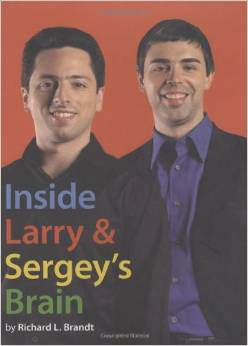Lessons from Google’s Larry and Sergey
I tell entrepreneurs that Google was an “exception” to all the investment and startup rules, but I’ve always wondered what it takes to be an exception. Since every business is built by unique individuals, I’m totally convinced that exceptional people are the key to an exceptional company.
To check out the Google founders, and because I still see so many business plans that are modeled after Google (more search engines, and more billion dollar growth models), I had to take a look at the definitive book about them, called “Inside Larry & Sergey’s Brain,” by Richard L. Brandt. It didn’t disappoint me.
This book was not sanctioned by Larry Page and Sergey Brin, so it’s not a love story. All the controversy is highlighted, but the message still seems to be that these guys were and are exceptional in their efforts to build a company. Here are some lessons from the book that all entrepreneurs should wish they could emulate:
- Independently outstanding, but complementary founders. Larry is the primary thinker about the company’s future direction, and weighs in heavily on key hiring decisions. Sergey, a mathematical wizard, is the arbiter of Google’s technological approach. Both have a deep sense of moral values and ethics, and work well together.
- Unique business tactics. Technology alone does not make a great company. Business tactics do. Google developed the most profitable form of advertising anyone had ever seen, ads selected real-time based on search terms. They focused on small advertisers looking for bargains. The model was a perfect fit for the Internet Age.
- Survived phenomenal growth. In 2003, just four years old, sales hit $1.5 billion, profit was $100 million, and it had taken over some 80 percent of the world’s search queries. Google now employs about twenty thousand people. Most founders don’t survive this kind of growth and change, but Larry and Sergey are still a well-balanced machine.
- Loved and hated at the same time. Larry and Sergey have been wickedly clever. They break the mold. They challenge old industries and make a lot of enemies. They’re ruthless businessmen. Yet through it all, they’re idealists, believers in the power of the Internet to make the world a better place.
- Surround themselves with the best people. Early on, they were able to get money from the likes of Andy Bechtolsheim and John Doerr. They convinced Eric Schmidt to take the reins with them for growth as CEO and now Executive Chairman, and had Dr. Larry Brilliant for the philanthropic arm for several years. Amazing.
- Continue to think big. According to the book, both founders continue to think big. Some of their ideas are as flighty as space travel; others are as grounded as the DNA that makes them who they are. No one proclaims to know where its leaders will take Google next, but everyone expects more great things.
Even the pros should probably pay attention here, to sharpen their game and to improve the accuracy of their assessments about people in general, as well as Google’s motivations and intentions. I think Larry and Sergey have shown a relentless focus on innovation that puts them miles ahead of competitors on all fronts.
I challenge each of you, as you reflect on your own vision and entrepreneurial plans, to take a lesson from Larry and Sergey. Do you have the intestinal fortitude to walk away rather than be “corrupted by financial interests,” or to ignore conventional wisdom and follow your own instincts? If so, then you too may be the exception that even the best and the brightest will line up to support. This world needs more exceptional people. Act like one and you too may beat the odds.

